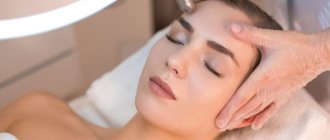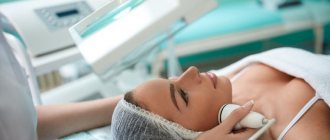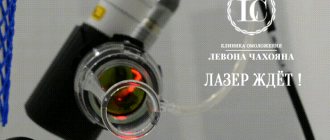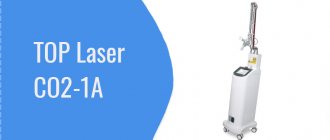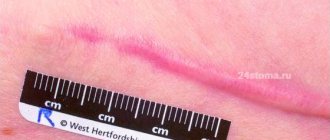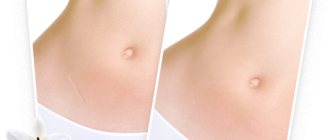The skin around the eyes is most susceptible to age-related changes in the face. Therefore, blepharoplasty, or eyelid surgery, has become the most popular plastic surgery in the facial area. This procedure is performed on patients with wrinkles on the upper or lower eyelids, bags under the eyes, and also to eliminate the effect of sagging upper eyelids.
Not so long ago, it was possible to get rid of congenital pathology of the eyelids or eliminate age-related changes only with the help of surgical intervention, but the development of hardware technologies in cosmetology has made it possible to correct eyelids without extensive surgery - today two non-surgical blepharoplasty procedures are available, which are an alternative to plastic surgery:
- Laser blepharoplasty using fractional CO2 laser SmartХide DOT;
- SMAS eyelid lifting using the Ultraformer 3 device.
Laser blepharoplasty
Laser blepharoplasty (Laser eyelid resurfacing) is a procedure that allows, without a scalpel or incisions, to reduce the skin of the upper and lower eyelids using laser action, as well as eliminate wrinkles around the eyes.
Today, this is a worthy alternative to surgical intervention, which has a number of undeniable advantages.
The procedure is performed using a fractional CO2 laser SmartХide DOT (Italy). This is a unique CO2 laser platform with an integrated innovative DOT Therapy® technique, which is absolutely deservedly the gold standard in the field of laser facial rejuvenation.
Contraindications
Laser eyelid correction is one of the safest procedures. However, due to the use of a high-temperature beam and a minimal incision to prevent complications, not everyone can undergo surgery.
Contraindications:
- HIV infection;
- diseases of the endocrine system, diabetes;
- increased sensitivity to the technique used;
- exacerbation of any chronic disease;
- inflammatory process occurring at the intended site of laser correction;
- any tumors, malignant or benign oncological formations;
- increased arterial and intraocular pressure;
- hemophilia, other blood diseases.
It is not recommended to perform blepharoplasty during pregnancy and lactation due to insufficient research and possible harm to the health of the mother and baby.
Features of the laser resurfacing procedure
The laser beam, penetrating deep into the skin, is divided into many microbeams, which create pinpoint microscopic damage in the skin. In areas of damage, intensive recovery processes are launched, since the ability of skin tissue to regenerate is very high. The targeted effect provides a sufficient supply of healthy cells (that have not been exposed to micro-rays), which serve as a source for the creation of new collagen and elastin. At the same time, the skin significantly contracts and tightens - pinpoint areas of damage “evaporate” micro areas of the skin. Due to these processes, the skin of the eyelids is tightened and wrinkles around the eyes are smoothed out.
What does the procedure give?
Laser resurfacing of the lower eyelids stimulates the division of fibroblasts - cells responsible for the production of collagen and elastin. The skin is evened out and becomes elastic. Venous outflow improves, swelling and “bags” under the eyes disappear. Thanks to laser resurfacing of the upper eyelids, wrinkles are reduced, the skin is tightened and acquires a healthy shade. The periorbital area and the upper third of the face are noticeably rejuvenated.
Price
| Laser resurfacing of face and body TOP CO2 | |
| Face+eyelids | RUB 28,100 |
| Face+eyelids+neck | RUB 32,450 |
| Upper eyelids | RUB 6,700 |
| Suture of the upper eyelids after blepharoplasty | RUB 3,700 |
| Lower eyelids | RUB 6,700 |
| Upper+lower eyelids | RUB 10,600 |
| Scar, scar beyond 1 cm (sq.) | RUB 1,650 |
| Anesthesia (application) small zone | 500 rub |
| Laser resurfacing of face and body Extra – Rubin | |
| Face+eyelids | RUR 33,750 |
| Face+eyelids+neck | RUB 38,950 |
| Upper eyelids | RUB 8,580 |
| Suture of the upper eyelids after blepharoplasty | RUB 4,600 |
| Lower eyelids | RUB 8,580 |
| Upper+lower eyelids | RUB 13,200 |
| Scar, scar beyond 1 cm (sq.) | RUB 1,980 |
| Scar, scar for 1 sq. cm (double grinding along the scar) | RUB 2,100 |
| Anesthesia (application) small zone | 500 rub |
| Laser resurfacing L-Rubin face and body | |
| Upper eyelids | RUB 4,600 |
| Lower eyelids | RUB 4,600 |
| Upper+lower eyelids | RUB 8,250 |
| Scar, scar beyond 1 cm (sq.) | RUB 1,550 |
| Scar, scar for 1 cm (sq.) double grinding along the scar | RUB 1,700 |
| Anesthesia (application) small zone | 500 rub |
Sign up for a consultation
Features of the SMAS lifting procedure
The Ultroformer 3 device uses HIFU (High intensity focused ultrasound) technology - high-intensity focused ultrasound penetrates several levels of the skin and reaches the muscular aponeurotic layer (SMAS). Under the influence of ultrasonic waves, the temperature of soft tissues at a microthermal point at a given depth increases to 60–70°C.
Directed radiation triggers the processes of contraction and compaction of SMAS, tissue repair, lipolysis, and also activates collagen production. Thermal damage stimulates the synthesis of a new collagen matrix, the renewal of which is completed in 3–4 months.
Indications for use
The possibility of laser resurfacing does not depend on the patient’s skin type, age, or gender. The procedure is performed according to indications, which include:
- the presence of wrinkles, scars;
- decreased skin tone;
- formation of stable bags;
- gravitational ptosis.
With the help of intervention, the drooping upper eyelid and drooping lower eyelid are corrected, and the deformed, asymmetrical shape of the eyelids is combated.
Important point! You can set the parameters of the laser beam to work with a specific skin type or defect variant.
Rehabilitation
After laser blepharoplasty, discomfort, swelling and redness that occur after the procedure disappear spontaneously within 2-3 days, depending on the type of laser and the power of the parameters chosen by the doctor. The swelling goes away completely after 7–10 days. In the first days after grinding, crusts form that cannot be damaged mechanically. They will go away within 5-7 days.
After SMAS eyelid lifting, immediately after the procedure, redness of the area that was exposed (from 20 to 60 minutes), limited swelling (3-5 days) may be noted. All these reactions pass quickly and do not require a recovery period.
Reviews from doctors
Anna Gennadievna, surgeon: Laser blepharoplasty is safe. For serious indications, more than 5 procedures are required in combination with other methods. After surgery, it is important to follow the specialist’s recommendations. Do not hesitate to ask and contact us if unwanted effects occur. Sometimes there is dry eye syndrome, severe swelling of the eyelids and pain. These conditions require the use of special medications.
Alina Viktorovna, cosmetologist: Laser eyelid lifting is recommended if other safe cosmetic methods are ineffective. During blepharoplasty, special attention should be paid to protecting the skin around the eyes from ultraviolet rays and injury. For a lasting result, you will need not one, but at least 3-5 procedures.
Sergey Vladimirovich, surgeon: Often it is necessary to correct complications after blepharoplasty performed by dubious specialists and in non-specialized institutions. The procedure itself is painless, safe, complications rarely arise if the doctor is sufficiently qualified and the patient follows the recommendations in the postoperative period.
Result
After laser blepharoplasty, the first visible effect of the procedure appears after the rehabilitation period, on average 5–7 days. At the same time, the skin noticeably tightens, becomes elastic, not only small but also deep wrinkles, scars and stretch marks disappear or are significantly reduced. The effect is increasing, most pronounced 2-3 months after the procedure.
After SMAS eyelid lifting, the first results of the procedure are noticeable immediately, the maximum effect is achieved after 3-4 months. It is recommended to repeat the procedure once a year.
Benefits of laser eye rejuvenation
- A noticeable rejuvenating effect not only of the periorbital zone, but also of the entire upper third of the face, which appears after a month and continues to increase over time.
- Short recovery period (2 - 3 days).
- No pain due to local anesthesia.
- Low cost compared to surgery.
Preparation for the procedure
Before the procedure, a preliminary free consultation with a doctor at our clinic is held. The specialist examines the area of future treatment, determines the presence or absence of contraindications, introduces the patient to the features of the laser rejuvenation technique for the eyelids and area under the eyes, and patient reviews with photos before and after the procedure help make the final choice.
Immediately before the procedure, it is not recommended to expose the skin to the sun.
Indications for laser rejuvenation of the eye area
- Bags, swelling, small hernias, dark circles in the eye area.
- Hyperpigmentation in the periorbital area.
- Capillary network around the eyes.
- Scars and other skin defects.
- Withering, wrinkles and other signs of aging of the skin around the eyes.
- Drooping of the upper eyelid.
Contraindications to the procedure
- Symptoms of a viral infection.
- Inflammatory processes in the treatment area.
- Bronchial asthma (except for mild severity).
- Systemic autoimmune diseases.
- Malignant tumor processes.
Stages of the procedure
Before laser treatment, 1 drop is instilled into the eyes. Alcaine anesthetic solution and special protective caps made of medical steel, pre-lubricated with Solcoseryl ointment, are put on the eyeballs. Such measures ensure complete safety and painlessness of the procedure.
Laser blepharoplasty takes place in 4 or 5 stages:
- At the first stage, laser treatment of the inner surface of the eyelids (conjunctival mucosa) is performed with a fractional beam of an ER: YAG laser in the Smooth FOTONA mode (a unique patented Fotona technique)
- At the second stage, the skin surface is treated with a neodymium laser ND:YAG FOTONA in order to affect the mid-dermis structures and the vascular component in Frac 3 mode.
- At the third stage, the tissues of the periorbital region and the middle zone of the face are uniformly heated with an ND:YAG laser in Piano mode.
- At the final stage, the skin is exposed to an erbium laser in Smooth mode - an ultra-long pulse to stimulate neocollagenesis and tissue tightening.
- An additional fifth stage - fractional laser resurfacing - is carried out in case of pronounced excess skin of the upper eyelid and its overhang.
What happens after laser treatment?
During the rehabilitation period (first 48 hours), the patient may feel a slight tingling sensation in the treatment area. Some swelling may also occur. These phenomena disappear within two to three days. According to patient reviews, a noticeable effect of skin rejuvenation in the area around the eyes occurs 3-4 weeks after one laser procedure and further intensifies within another month.
IMPORTANT! To obtain a stable and long-lasting anti-aging result, a course of three procedures is recommended with a frequency of 40-60 days.
Results of laser eye rejuvenation procedure
- The deep layers of the dermis are reconstructed.
- The production of new collagen is stimulated in all layers of the skin of the eyelids and the area around the eyes.
- The stratum corneum of the epidermis is removed, which leads to skin lightening and elimination of age spots.
- The tone and turgor of tissues are restored.
- Small wrinkles are completely smoothed out and large ones are significantly reduced.
- The sagging of the upper eyelid is eliminated.
- After 4D laser rejuvenation of the midface, it looks fresher and more attractive.
Frequently asked questions about laser eye rejuvenation
How long does this procedure take? On average about 1 hour. Is it possible to combine laser eye rejuvenation and Botox injections? It's not worth combining. To enhance and prolong the effect, it is recommended to combine the laser rejuvenation procedure for the area around the eyes, for the upper and lower eyelids with biorevitalization with hyaluronic acid or bioreparation of this area. And the question of administering botulinum toxin type A drugs - Botox, Dysport, etc. (if necessary) should be postponed for at least 2-3 months after the procedure. At what time of year can laser eyelid rejuvenation be performed? Anytime. The procedure has no seasonal restrictions.
Advantages and disadvantages
A clear advantage of using a laser is the ability to quickly and effectively eliminate age-related changes and scars. This option can be used for treating delicate areas; spot application is possible.
The disadvantage of laser correction is its high cost. Sometimes a single session is not enough to get the expected result.
Each procedure requires preparation and rehabilitation. In most cases, the use of a laser is combined with plastic surgery, which ultimately gives the optimal effect.
Using different types of lasers to treat scars
Modern hardware cosmetology uses several types of lasers. The most common type is carbon dioxide (CO2) laser. It can be either total or factional. Fractional laser produces electromagnetic radiation segmented into thin beams. Each beam, acting on the skin, produces thermal evaporation of a narrow column of cells. This creates a fine mesh of perforated and healthy areas of the skin. Outwardly, this differs little from conventional classical laser processing. But as a result, the skin adapts more easily to such effects, healing and regeneration occur faster.
To treat scars, both fractional laser and classic CO2 resurfacing are used, as well as chemical peels.
Facial resurfacing with a fractional laser has shown high effectiveness in the treatment of post-acne (acne consequences, acne scars). External manifestations of post-acne can be depressions in the form of “wells”, hypertrophied (protruding areas), as well as age spots.
Consecutive implementation of several procedures results in almost complete renewal of the skin's upper layer of epithelium. In other words, the skin is being renewed to the depth of post-acne. As a result, the skin becomes evenly smooth, elastic, and acquires a natural color.
Opinion of cosmetologists
Doctors believe that achieving an ideal result requires a comprehensive assessment of the situation and a complex approach to the patient. Cosmetologists claim that the technique is ideal for combating minor imperfections and correcting traces of blepharoplasty. When performing laser resurfacing as an independent rejuvenation procedure, there is a high risk of various complications with an average quality of result.
The cosmetologist admits the low effectiveness of the intervention for older patients.
A cosmetologist works with a laser and claims that to achieve results, many nuances will have to be taken into account.
Precautionary measures
Laser resurfacing is prohibited if contraindications are identified:
- inflammatory diseases in the eye area;
- impaired integrity of the integument;
- insufficient level of rehabilitation after surgery;
- relapse of herpes;
- impaired blood clotting;
- oncology;
- serious problems with the heart and blood vessels;
- tuberculosis;
- diabetes;
- epilepsy;
- tendency to keloid scarring;
- presence of a pacemaker;
- pregnancy, lactation.
The procedure is also excluded if you feel unwell until the condition stabilizes. Manipulation is not carried out if the skin is excessively dry or dehydrated. It is recommended to first take measures to improve the quality of the epidermis.
If laser treatment is performed correctly and the patient strictly adheres to rehabilitation restrictions, complications do not arise. If these factors are violated, the following may occur:
- hyperpigmentation;
- long-lasting erythema;
- excessive swelling;
- infections;
- excessive scarring.
Moderate discomfort may persist for up to a week. During this period, redness and swelling disappear. If the symptoms persist, it is better to additionally consult a doctor. What should alert you is that the eyelids have acquired a brown tint, are swollen, and are oozing ichor.
